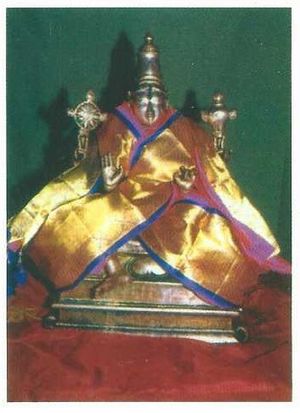Utsavamurti
By Swami Harshananda
Definition of Utsavamurti[edit]
The main image in the temple is generally made of stone and is fixed permanently to the pedestal. It is called dhruvabera or acalabera. Apart from this, there will be a few more[1] icons made of metal. They are movable ones, hence they are called calaberas or calamurtis. The most important of these, which is used for processional purposes, either in a ratha[2] or in a śibikā,[3] is called utsavamurti or utsavabera.
Significance of Utsavamurti[edit]
Being next in importance, it is usually kept in the sanctum close to the main image and connected with it by a golden thread called sambandhasutra. It may also be kept outside the sanctum in a separate cell called ardha-maṇḍapa or śukanāsī. This image is an exact replica of the original, except in the case of Śivaliṅgas, and is big enough to permit elaborate decorations with garments, garlands and ornaments. It should always be either in the standing posture[4] or sitting posture[5] but never in the reclining[6] posture even though the dhruvabera[7] may be in that posture.
Routine Celebrations for Utsavamurti[edit]
No worship is normally offered to the main image in the temple as long as the utsavamurti is out. The utsavamurtis of Viṣṇu in any aspect are always accompanied by the images of Śrīdevī and Bhudevī even though these images may not be there in the main sanctum.
References[edit]
- The Concise Encyclopedia of Hinduism, Swami Harshananda, Ram Krishna Math, Bangalore


